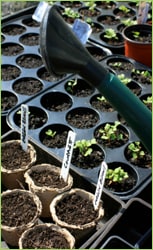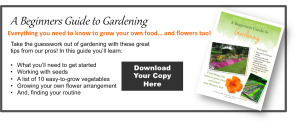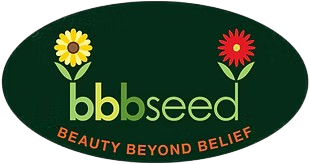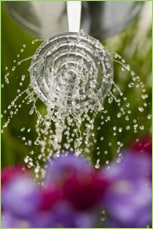Vegetable Seed Starting
 Starting your vegetables and herbs indoors from seed is easy and very rewarding. By starting indoors you give yourself a jump-start on the growing season and you will be ahead of the game when it is time to start planting outdoors! The back of your BBB seed packet will have the basic information you need to know to ensure you have successful germination.
Starting your vegetables and herbs indoors from seed is easy and very rewarding. By starting indoors you give yourself a jump-start on the growing season and you will be ahead of the game when it is time to start planting outdoors! The back of your BBB seed packet will have the basic information you need to know to ensure you have successful germination.
Here are a few tips to remember to kick off your seed-starting efforts.
- Plastic pots are best for starting seeds as they retain moisture more easily compared to terra cotta or other clay pots. If you don’t have traditional seed-starting containers available from your local garden center you can use recycled yogurt cartons, salad containers, or any other plastic container you find in your recycle bin! You can also make your own wood seed starting trays or your own newspaper pots. No matter what type of container you use make sure it is clean and sterile.
- Proper drainage is essential. Make sure there are holes in the bottom of your seed starting container to allow for good drainage. If you are using a recycled plastic item you can drill or poke holes in the bottom by using a screwdriver or nail. Excessive moisture trapped in a pot can lead to damping off and other fungal diseases. Ew!
- Soilless seed starting mix. Really we mean it! If you want good germination start your seed in a soilless mix. The key is that when your seeds germinate and have at least their first set of true leaves you must transplant them to the next pot size up and into regular potting soil. Or, you need to start feeding them with a half-strength fertilizer. The soilless mix is essentially sterile with minimal nutrition which is a perfect medium for your plants to germinate in. Less chance for contamination or other weird diseases to set in!
- Moisten your mix. Pour your soilless mix into a bowl. Moisten it with water so that it isn’t soaked, but is nicely damp. Fill your seed starting pot or tray up ¾ of the way full with your damp soilless mix. Gently press the seed into the soil approximately two (2) times the depth of the diameter of the seed. Then lightly cover your seed with more of the soilless mix. Gently press the soil to ensure good seed-to-soil contact.
- Identify each pot. Even if it is only 2 pots we highly recommend that you mark each pot with the name of the vegetable and the date planted. You can use wooden craft sticks, left-over popsicle sticks, or any other object that sticks up and beyond the soil that you can write on.
 Water gently. We can’t tell you how many times we have washed away seeds and newly born seedlings by watering too hard! We recommend watering from the bottom by placing your seed starting container in a dish or basin filling it with water 2-3 inches and allowing the moisture to be drawn upward. If just the top has dried out use a spray bottle or a child’s watering can with small holes. And if you don’t have either, while pouring out the water (gently!) put your hand in between the water and the soil to break the fall of the water before it lands on the seeds or tender seedlings. Water daily and remember, gentle!
Water gently. We can’t tell you how many times we have washed away seeds and newly born seedlings by watering too hard! We recommend watering from the bottom by placing your seed starting container in a dish or basin filling it with water 2-3 inches and allowing the moisture to be drawn upward. If just the top has dried out use a spray bottle or a child’s watering can with small holes. And if you don’t have either, while pouring out the water (gently!) put your hand in between the water and the soil to break the fall of the water before it lands on the seeds or tender seedlings. Water daily and remember, gentle!- Cover! Immediately cover your pot with a piece of saran wrap or a plastic bag to help retain the moisture. If you have a garden dome then place the lid on top. Keeping your seed evenly moist until germination is essential.
- Temperature. Most seeds require temperatures of 65° to 75°F to germinate. The back of your BBB Seed packet will tell you the preferred germination temperature for your seed. Place your seed containers near an existing heater, on top of the stove (pilot lights can be very warm at night!) or use a space heater with the proper precautions to raise the ambient temperature as needed. Heating pads designed specifically for plant use can also be placed directly under the seed containers which will encourage germination.
- Good Light. Plants require at least 12 hours of daylight. If you are starting your seed where light is poor or during a time when there is less than 12 hours of light per day we recommend growing lights. If sowing your seed indoors, place your seed containers in a sunny, south-facing window and give the container a quarter turn each day to prevent the seedlings from overreaching toward the light and developing long and weak stems.
- Acclimate Your Seedlings. Before you transplant your seedlings outdoors they need to be hardened off or acclimated to direct sunlight and fluctuating temperatures. It is best to do this over a three-to-five-day period by placing them in direct sunlight during the morning only on the first day, then increasing their time outside by a few hours each day until they are strong enough to be transplanted. Don’t feel rushed. If unexpected weather or wind arises, keep them indoors. Nothing is more disappointing than spending all of your time growing your precious seedlings to then having something go wrong when you put them outside.
If you have any questions at all about how to start your BBB Seed please do not hesitate to email us at info@bbbseed.com. We look forward to answering any questions you might have!
Download our E-Book here:



